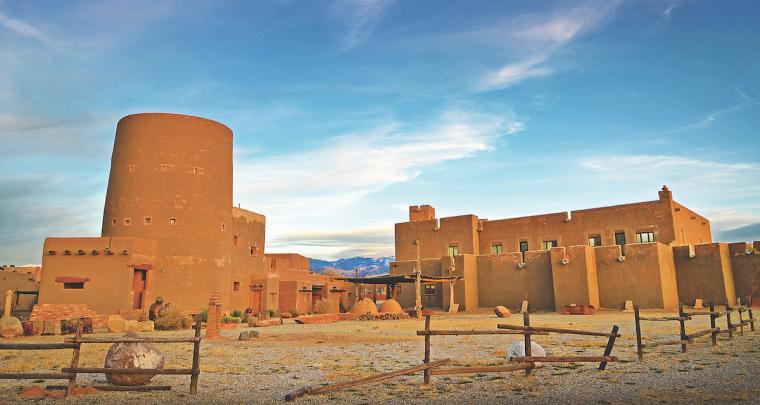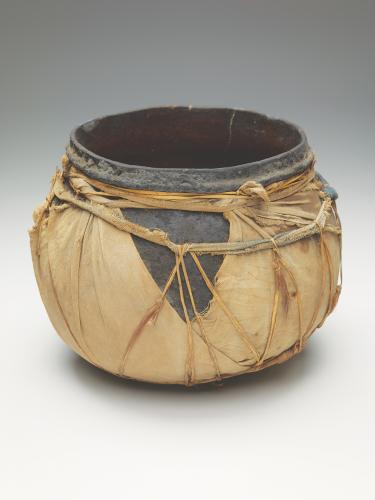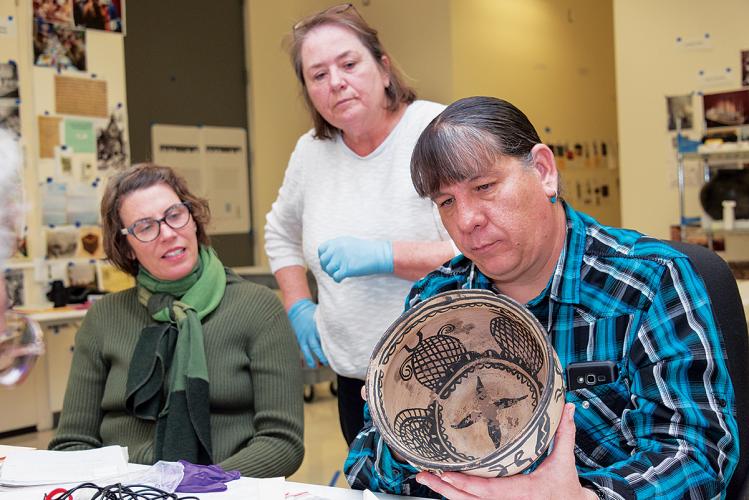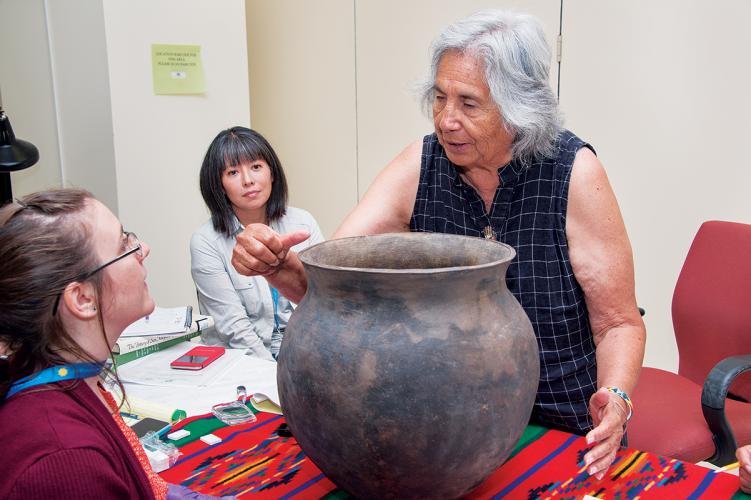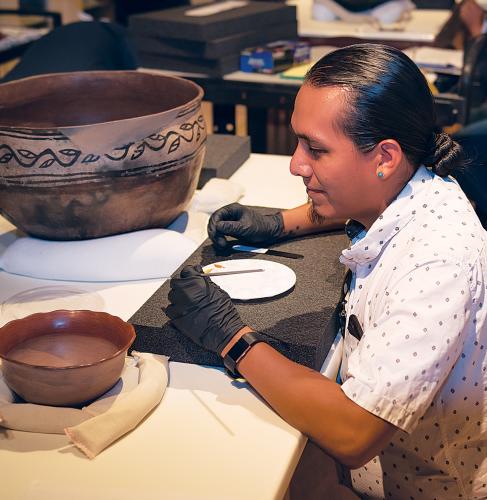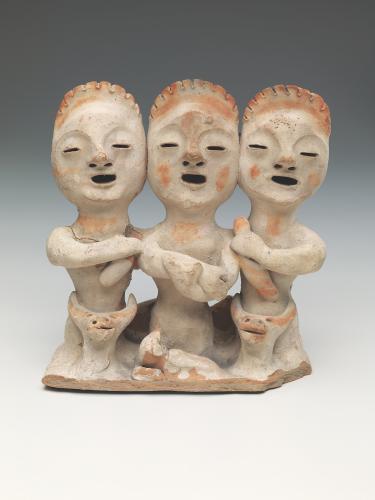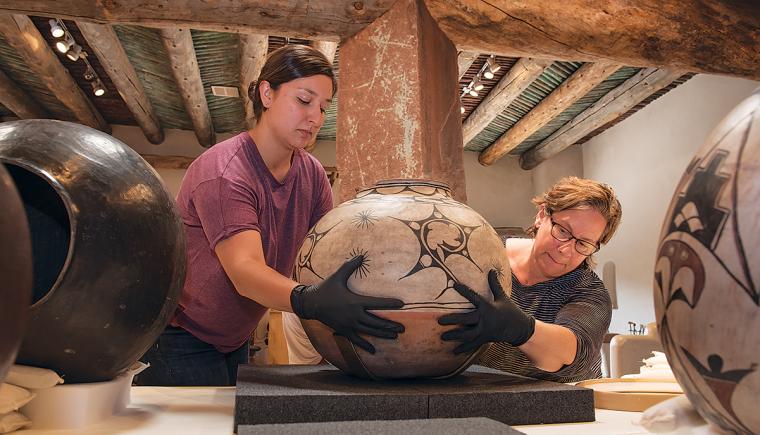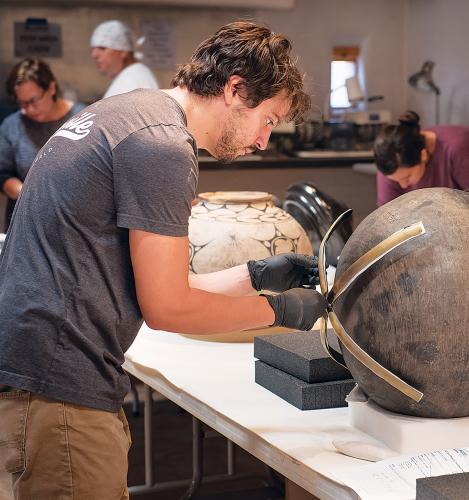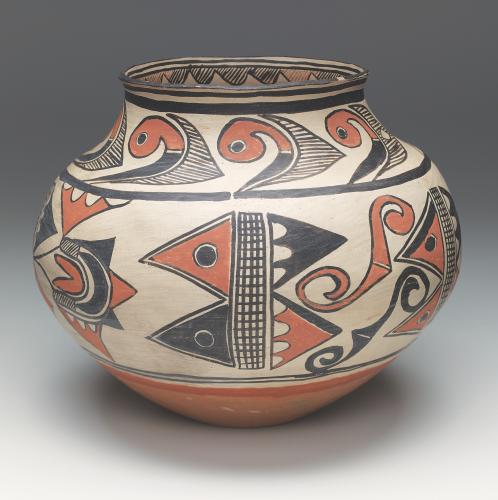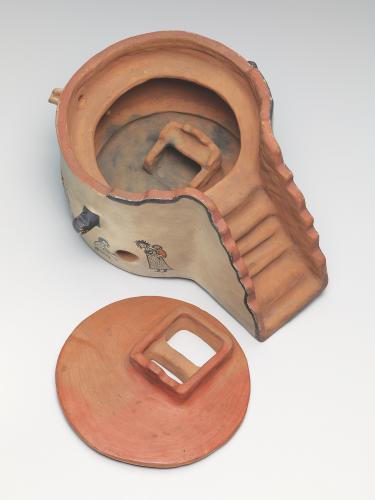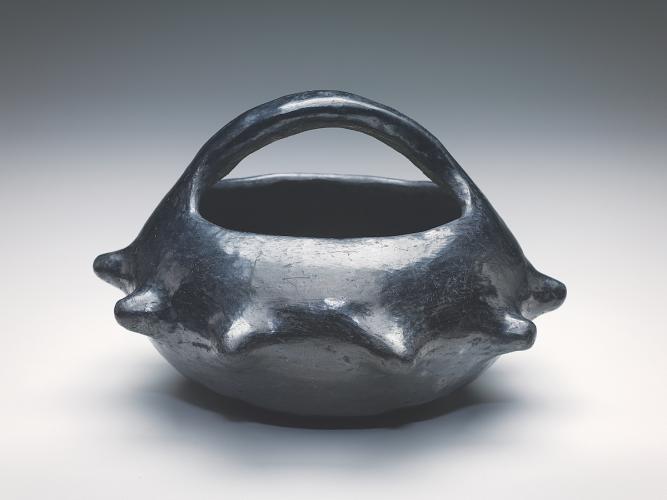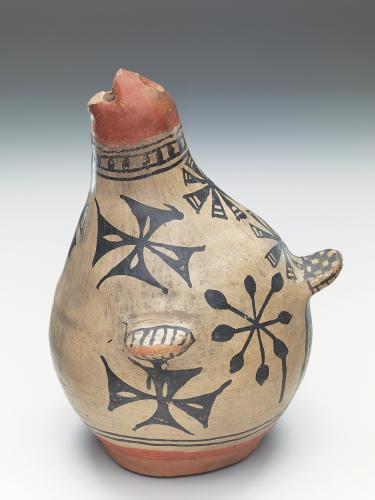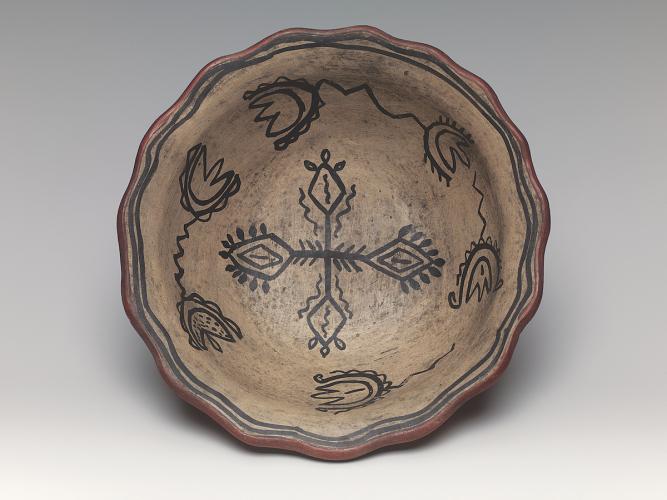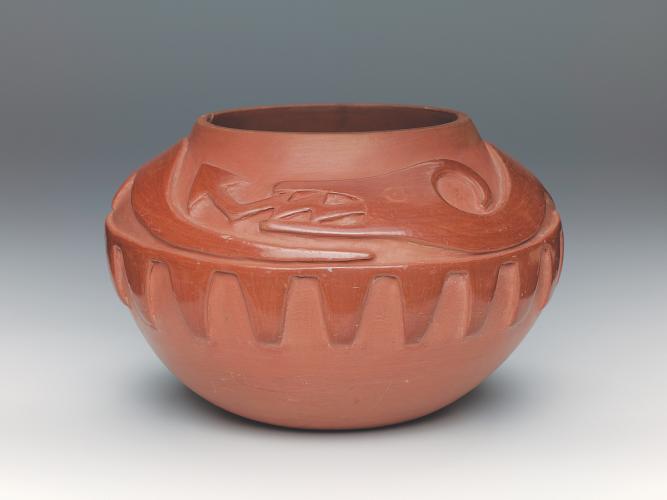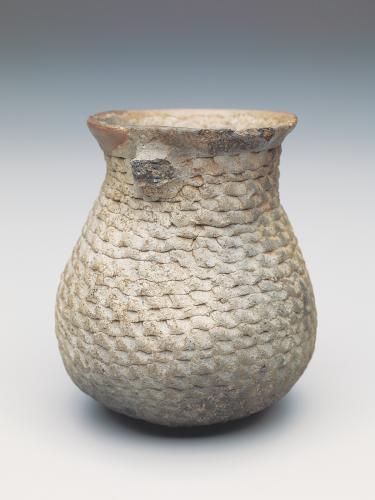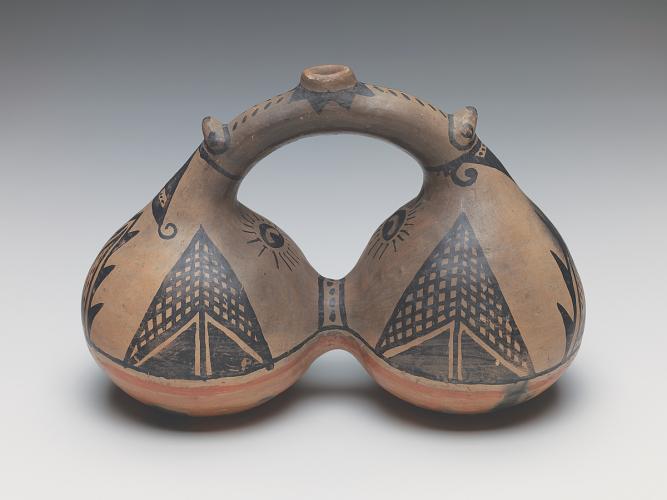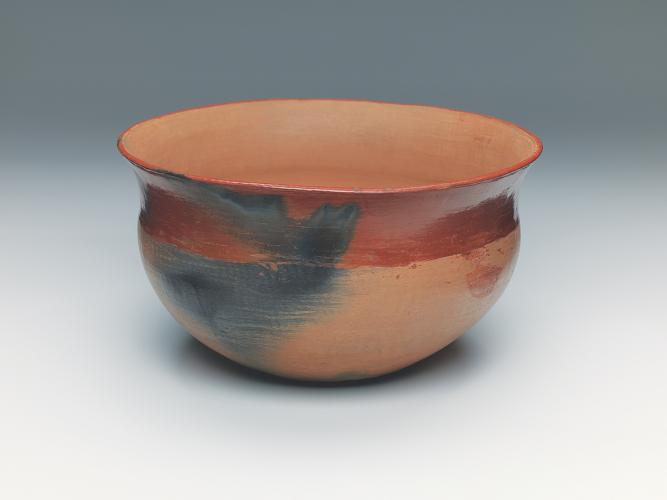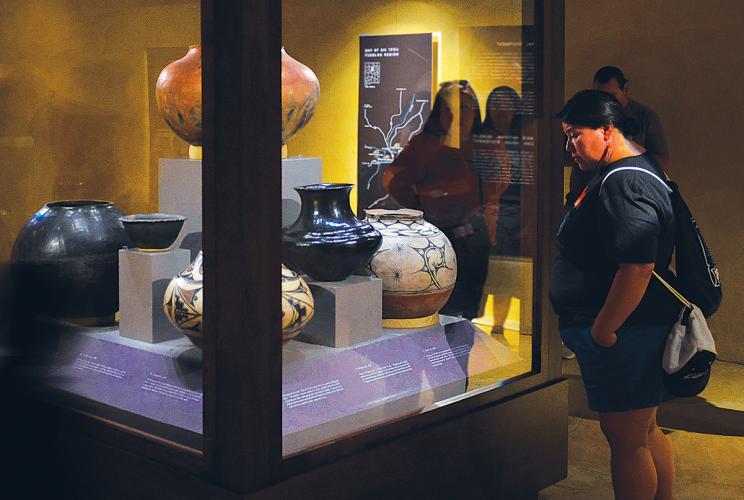A Tewa pot is never empty—and while used or cared for, always alive. Whether a large storage jar tucked away in a pantry or a flat bowl brimming with beans at a family feast, it is heavy, laden with hundreds of years of stories. And even if a jar or bowl is not in use, it is only dormant, anticipating the moment that it will once again be awakened by the touch of Tewa hands.
Anticipating is what a National Museum of the American Indian collection of 100 Tewa pots from six pueblos in New Mexico have been doing for more than a century. Tessie Naranjo says, “We believe they are anxiously waiting to get home.”
Naranjo's family is among the generations of skilled Tewa potters from those six pueblos—Nambé, Ohkay Owingeh (formerly San Juan), Pojoaque, San Ildefonso, Tesuque as well as her own home of Santa Clara—straddling the Rio Grande River in north-central New Mexico. From the mid-19th century to the early 20th century, various collectors acquired the Tewa pots and then curators donated them to the museum. Ranging in size from a few inches in diameter to more than 2 feet tall, they survived—and slept—for a century. For the past 20 years, they have been carefully curated at the museum’s Cultural Resources Center in Suitland, Maryland.
In 2012, the Pueblo of Pojoaque’s then-Governor George Rivera and the village’s Historic Preservation Officer Bruce Bernstein approached NMAI and suggested it was time for these pots to be back among the Tewa people through a long-term loan. NMAI readily agreed. “Our philosophy is that we are stewards of these collections. We are taking care of them for future generations,” says NMAI’s Assistant Director for Collections Cynthia Chavez Lamar (San Felipe Pueblo/Hopi/Tewa/Navajo). “Yet these are things that may never otherwise be seen if they don’t travel.”
And travel they have, and will again. After several years of collaboration between the Tewa communities and NMAI, nine of these pots have traversed nearly 1,900 miles to the Poeh Cultural Center in Pojoaque, and soon the remaining 91 will join them. All will be displayed in an exhibition called “Di Wae Powa” (They Come Back) beginning October 12. Yet even after the exhibition opens, their life’s journey will not have ended. Each vessel represents a long history— not only of pottery making but of the Tewa people—and these pots’ stories are far from over.
The Tewa P'o-eh
That these Tewa pots have been on a journey is appropriate, for as their people say, every life takes a continuous path, or “nambi p’o-eh,” and only through movement can growth occur. Along the way, one must gain knowledge and then return home to share that with one’s community. In this way, a Tewa person finds his or her “middle place,” a place of balance and purpose that is above our beginnings in the underworld and yet not yet above, where the journey ends. “You find your p’o-eh, your path, how to be a Pueblo person in part through stories,” says Poeh Cultural Center Executive Director Karl Duncan (Arikara/ Hidatsa/ Mandan/San Carlos Apache). “These pots are going to be providing an enormous wealth of knowledge through their stories.”
The Tewa people take their name from their language, one of seven in the Tanoan language group of Pueblo people of New Mexico and Arizona. As told in the 2019 book “The Continuous Path,” movement is important to the Tewa culture, so they were a highly mobile people. They had migrated to their present-day villages during the 13th century. Even so, intermarriages and trade between villages continued so pottery styles were exchanged.
After the Spanish arrived during the 1600s, the Tewa invented new pottery styles to reinforce their culture. When the Tewa began to grow wheat, they began making larger jars to store the grain and large, flat bowls in which to mix bread dough. They also began making black pottery and ones with black cloud designs. Black pots are formed when cow or horse dung is used to fuel and then to smother the fire so that the black smoke produced deoxidizes the clay, turning it black. They also began to make a lot of polished black, or Kapo pottery, a style that may have been introduced by Mexican Indigenous populations who came to New Mexico with the Spanish. After the 1680 Pueblo Revolt during which villagers drove out some of the Spanish, the Tewa potters again invented new styles, creating more plant-based designs and replacing tall-neck and indented-bottom jars with bulbous jars. Black on white pottery continued until the mid-1700s. Then very large bowls and jars known as ogapage polychrome, designed with black and red paint on a white slip coating, became prevalent in Tewa culture.
Fiery Births and Deaths
No matter for which purpose or in which style the Tewa people make their vessels, the process is a ritual and a prayer. It combines two fertile substances, water and earth, to create life. “We live in an organic world. All things have life. Clay has life,” says Naranjo. “I remember my mother would pray to the pit from where she would take the clay. She would say, “I am going to bring you home, but it is okay, because I need you and I will make good use of you.’”
Until the mid-20th century, the molding of clay into a pot was primarily a Tewa women’s skill, yet some powerful motifs such as mountains, lightning bolts and water serpents were the responsibility of the men. Today, women and men craft pots, although some decorations still belong to men. Erik Fender from San Ildefonso Pueblo chose pot making for a living to continue his family’s legacy and because, he says, so few do in his village: “There’s too much hard work and risk involved to rely on the clay.”
Although each potter may have his or her own techniques, the general steps to making a pot are similar. After gathering the clay, rocks and other impurities are removed and the clay is then soaked for days. A bonding agent, or temper, such a volcanic ash or sand is mixed in and then the moist clay is left “to age” in bags for a couple of weeks, says Fender. When it is the right plasticity, not too wet or dry, the clay can be molded, either from a lump into a small pot or figurine or from stacked coils that are then smoothed together into a larger vessel. Then the pot is left to dry until is its “leather hard,” after which it can finally be carved. Once completely dry, it can be smoothed with sandpaper or a wet cloth and dried again prior to burnishing it smooth with a stone. Then it can be covered with red or white slip and decorated with paint. Only then is it ready to be baked in a fire.
Because so much can go wrong in making a pot—too much temper, too wet, the fire too hot—Fender thinks “good thoughts and prayers” at every step. Yet it can still crack or explode in the fire. “We potters call firing ‘final judgement’ because months of work can be lost in a matter of minutes,” says Fender. If a pot dies in the fire, Fender will break it up and give the clay “back to the spirits.” He says that is “part of the beauty of the process. Not everything is going to survive.” Yet making pots is worth the potential heartbreak, he says, as “pots are part of all stages of our life. We are born with pottery, and we die with pottery.”
The Long Journey Home
In 2016, Fender was one of the representatives from each of the six Tewa pueblos who came to NMAI’s Cultural Resources Center to select which of the more than 200 Tewa pots there should go to the Poeh. The 100 chosen represent a variety of styles and designs as well as all the Tewa villages. None of those selected had been excavated or used in ceremonies, nor were any signed by a person or family.
Naranjo and others from the Tewa communities came in 2017 to advise how the pots should be handled for greatest preservation, how they should be displayed and what stories they could tell. For example, a cooking pot and a canteen had evidently been well-loved, as despite being broken, they were held together with pieces of twine and cloth to extend their life.
The next step was to have NMAI staff visit the Poeh Cultural Center and help its staff determine what kind of mount would best cradle each pot to keep it stable while being displayed. Nine of the pots had been sent to the Poeh previously to serve as prototypes. During August 2018, NMAI’s master mountmaker Shelly Uhlir and one of NMAI’s emerging Native museum professionals, Tazbah Gaussoin (Picuris Pueblo/ Navajo), helped teach the Poeh staff, Native museum professionals as well as local jewelry artists and potters how to forge brass mounts. Working in the Poeh’s jewelry studio for a week, the group created mounts for the first nine pots.
Now the rest of the pots are being prepared for their final leg of their long pilgrimage home. NMAI staff will keep in touch with those at the Poeh to make sure the pots are comfortably housed under the right temperature and moisture conditions so they can potentially remain at the Poeh for years to come.
Living Legacies
When all 100 pots are finally together at the Poeh, they will be placed on earth-toned, tiered steps, as if they were perched on kitchen shelves or stairs outside a Pueblo house. “We want the pots to feel that they are coming home to Tewa country,” says Stephen Fadden, the Poeh’s director of programming. “People are being with the pots rather than looking at the pots. The pots are watching you as you are walking in.”
Yet the arrival of the pots at the Poeh Cultural Center is really “just the beginning of the project,” says Bernstein. Visitors will be able to learn and perhaps tell their children about traditional pottery making and what pots mean to the Tewa people. Some pots become part of a “teaching collection” that local potters will be able to examine closely, seeing the techniques and designs of their ancestors, if not their families. Fender has already started to incorporate this knowledge into his own art. “It has been a huge source of inspiration to recreate the old styles and shapes,” he says. “Finding out which families made the pots may in fact reveal hidden histories of these pueblos,” says Fadden. Next year, the Poeh plans to begin recording those stories.
This long-term loan with the Poeh Cultural Center is just one of similar partnerships the NMAI is striving to build with other Native communities, including the Makah Tribe in Washington State and White Mountain Apache Tribe in Arizona. Having grown up in San Felipe Pueblo, Chavez Lamar says the pots’ return home is “emotional for me, too. I know what it means when you see things your ancestors touched and made, to have this sense of awe and appreciation that they exist. Whatever we can do as a museum to connect Native peoples with collections is very important.”
“This is a co-stewardship,” says the Poeh’s Duncan. “This will serve as a model and process that can be replicated by other tribes and groups that want to bring collections back to their communities. Connecting elders to younger generations and tribes to other institutions—that’s really positive. This is a prototype that is going to evolve.”
Through such renewed purpose, perhaps the Tewa vessels will finally find their “middle place.” Naranjo says, “We cannot wait for these 100 pots to get home to us so they can more easily breathe again.”
Beginning October 12, 2019, 100 Tewa pots from the NMAI collection will be displayed in the “Di Wae Powa” (They Come Back) exhibition at the Poeh Cultural Center in Pojoaque, New Mexico.

